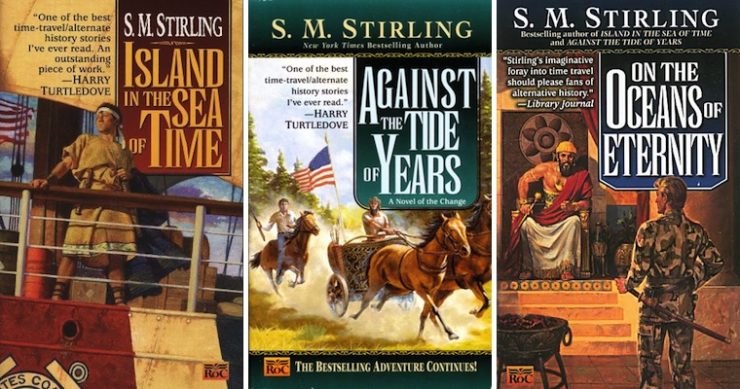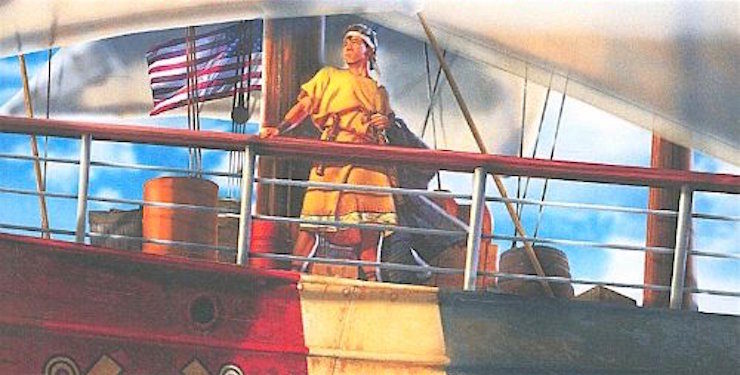In this bi-weekly series reviewing classic science fiction and fantasy books, Alan Brown looks at the front lines and frontiers of the field; books about soldiers and spacers, scientists and engineers, explorers and adventurers. Stories full of what Shakespeare used to refer to as “alarums and excursions”: battles, chases, clashes, and the stuff of excitement.
Today, we’re going to visit the first book in a long-running series that looks at two major questions: What would happen if people with the technology of today were transported to a world that lacked it? And what would happen if the world of today lost its technology? The answers, in the hands of author S.M. Stirling, provides the setting for some of the best action and adventure stories ever written. Island in the Sea of Time is the first book of S.M. Stirling’s Change series, a gripping story of ordinary people facing extraordinary circumstances, in some cases rising to the occasion and trying to do the right thing; in others, giving in to their worst impulses.
The book participates in a long tradition of tales where modern protagonists travel to the past (or sideways in time) and utilize their knowledge to reshape more primitive societies, including Mark Twain’s A Connecticut Yankee in King Arthur’s Court, L. Sprague DeCamp’s Lest Darkness Fall, H. Beam Piper’s Lord Kalvan of Otherwhen, and Harry Turtledove’s The Guns of the South. It is also a clear inspiration for Eric Flint’s 1632 series, which transports a West Virginia town back over three centuries into war-torn, seventeenth-century Germany.
The book, by transporting the U.S. Coast Guard Barque Eagle into the past along with the island, also offers a rare opportunity for the Coast Guard to take a starring role in a science fiction story. As someone who spent about 14 weeks of his youth aboard the USCGC Eagle, I was delighted to see this old friend getting some well-deserved attention. (And, on a related note, I also recently saw that author Myke Cole will be offering us more science fictional Coast Guard adventures in the near future.)
About the Author

Stephen M. Stirling was born in France in 1953 to a Canadian father and English mother, and is now a naturalized U.S. citizen who lives in New Mexico. He is a martial arts enthusiast, and well versed in history and technology, something that is quite apparent in his work, which often features well-thought-out descriptions of hand-to-hand combat, tactics, and technology. He has spent a fair amount of time on the island of Nantucket, gaining knowledge that he used to good effect in writing Island in the Sea of Time. Stirling is best known for his stories of alternate worlds, where history has followed a different path than in our own reality, and his stories put military adventures, action, and exploration front and center.
His first published novel was Snowbrother, a post-apocalyptic adventure novel published in 1985. Early in his career, he collaborated with a number of other authors and participated in several shared world anthologies. Of note are his contributions to Jerry Pournelle’s Empire of Man series, with two novels cowritten with Pournelle (Go Tell the Spartans and Prince of Sparta), and shorter contributions to the War World series. He also collaborated with Pournelle and others on Niven’s Man-Kzin War series. An excellent series of military SF books co-written with David Drake, the General series, features an officer who develops a telepathic link with an ancient battle computer and fights on a far-away world with technology similar to Earth’s in the 19th Century.
Many of Stirling’s books are part of longer series, which might intimidate some readers. For those looking for standalone works, I would recommend The Peshawar Lancers from 2001, an adventure set in a British Empire where Britain became uninhabitable, or Conquistador from 2003, an adventure set in an alternate version of California. Two other standalone, but related, books are The Sky People from 2006 and In the Courts of the Crimson Kings from 2008, set respectively on a Venus and Mars that are found to be not only habitable, but inhabited.
Stirling also found success with a solo series from Baen Books that created the ultimate villains: the fictional nation of Draka, a racist slave state founded in Africa after the U.S. Revolutionary War, which by World War II has become a world power. While these books were well written, however, I found the Draka worldview so despicable that it was difficult to read them.
Stirling’s most popular series are the novels of “The Change,” which began with Island in the Sea of Time in 1998 (the first book in his Nantucket series), and has grown to include The Emberverse books—at least 17 books in all, with more on the way. In my opinion, he truly hit his stride with these books, and they include some of his best writing.
The Change Series

“The Change” is a mysterious event that took place in 1998, and transported the island of Nantucket and the USCG training barque Eagle back into the past of 1250 BC. The Nantucket trilogy, which includes Island in the Sea of Time, Against the Tide of Years, and On the Oceans of Eternity, follows the adventures of the people of Nantucket as they struggle to survive in the ancient past, bringing modern technology to the Bronze Age.
The related Emberverse series, which began with Dies the Fire, was at first not obviously connected with the Nantucket books. It too starts with a mysterious event, when the world suddenly finds that modern technology—including firearms, steam and electrical power, and electronics—has ceased working. The collapse of technological civilization leaves the world unable to sustain its population: most cities collapse into chaos, and in many areas, survivors resort to cannibalism. The first three books (Dies the Fire, The Protector’s War, and A Meeting at Corvallis) deal with survivors in the U.S. Pacific Northwest organizing themselves to meet the challenges of the transformed world. Distinct groups of people turn out to have unique skills that help them survive, and become focal points for building a new civilization: a group of Wiccans, university staff, members of the Society for Creative Anachronism chapter, and small farming communities. When the SCA organization grows into an oppressive dictatorship, the other groups rise to face them.
The next books, which include The Sunrise Lands, The Scourge of God, The Sword of the Lady, The High King of Montival, The Tears of the Sun, Lord of Mountains and The Given Sacrifice, follow the adventures of Rudi Mackenzie, son of two of the leading survivors of the Change, as he becomes King of a new nation known as Montival. While the impetus for the Change was unexplained in the first trilogy, in these books, the hands of metaphysical powers of good and evil begin to show, and as the spiritual beliefs of the characters grow in importance, so does the richness of their personalities. The ties to the Nantucket trilogy also become explicit, as Rudi goes on a quest to Nantucket, which has become a nexus between realities, and gains a sword with strange powers that he uses in his struggle with the evil forces that have entered the world.
The next series of books, which remains unfinished, so far includes The Golden Princess, The Desert and the Blade, Prince of Outcasts, and The Sea Peoples, and follows Rudi’s daughter and son, Órlaith and John, as they grow into leaders themselves, facing both physical and paranormal threats.
The Change series is an epic that ranks among the best that science fiction has to offer. If you enjoy action and adventure, you will find both in great abundance here. The characters are engaging, the backdrop for their adventures is engrossing, and the attention to detail is superb. I have to say that this series has given me a great deal of enjoyment for two decades now, and if Stirling decides to end it any time in the near future, I will be disappointed. For now, lets take a look at the book that started it all…
Island in the Sea of Time
The book opens with the March arrival of historian Ian Arnstein on Nantucket, a bit early for the summer vacation season. Shortly afterwards, a mysterious dome of energy cuts the island off from the outside world. Even after the dome disappears, there is no way to contact the outside world with the exception of the USCGC Eagle, which had been on a training cruise near the island. Police Chief Jared Cofflin takes charge of the situation and calls a town meeting for the next day. Astronomer Doreen Rosenthal calls him and reports that the stars are in the wrong places: they are no longer in 1998. In the morning, Cofflin hires a private floatplane, takes aboard Lieutenant Walker from the Eagle, and they fly to the mainland—only to find it covered with unbroken forest. They see a native village on the shore, land the plane, and are immediately attacked by frightened natives using Stone Age technology.
Eagle’s Commanding Officer, Captain Alston, is an African-American woman from the Carolinas, a region where there is a long tradition of African-Americans serving in the Coast Guard. She is, unusually for a Coast Guard officer—but fortunately, given the circumstances—a student of martial arts and Japanese sword fighting, and of military history. She is also a closeted lesbian, this book taking place in the days before gays were allowed to serve openly. Serious and duty-bound, Alston is a very well-realized character. She also represents something I found different in this book from Stirling’s previous work: While his tactics and technology had always been topnotch, I felt his characters had sometimes been on the thin side, especially the heroes. That changed with this novel, as the entire cast feels real and compelling—even Chief Cofflin, and it can be hard to breath naturalistic life into a “taciturn New Englander” character on the page.
At the town meeting, Doreen Rosenthal announces that she has been able to fix the date using the position of the stars, and that the island has been transported to 1250 BCE. Captain Alston, ashore for the meeting, agrees with that assessment. Ian Arnstein finds that his knowledge as a historian is suddenly not so theoretical, and Martha Stoddard, the local librarian and an amateur archaeologist, also emerges as a resource. The Town Council is not functional, as key members were off island or are not capable of dealing with the situation. The group grants Chief Cofflin emergency powers, which he uses to organize the island to support itself. He appoints a council to advise him, including Arnstein, Rosenthal, Captain Alston, local politician Joseph Starbuck, farm owner Ms. Brand, and Pamela Lisketter, a local weaver and “simple” lifestyle enthusiast. It is fortunate that the event occurred during the off-season, as the island would not have been capable of supporting the full summer population for any length of time. The inhabitants quickly organize in order to share food and resources collectively and to plant all the crops they can. Their efforts are aided by the fact that there is marine life in abundance: the heavy fishing of the modern era has not occurred, and there are rich stocks of whales, cod, and other fish available, along with migratory birds in numbers that shock the islanders.
The book spends a great deal of time focusing on the challenges of keeping about seven thousand people alive when all outside support disappears. The islanders find themselves reviving old technologies like steam power, and blacksmiths and machinists soon find themselves very much in demand. Whaling again becomes a major industry for the island, and soon whale oil lamps become the primary source for light in the evenings. Not everyone is content with their new life, especially those who worked in sedentary pursuits and now find themselves toiling in the fields. These challenges give the book a positive tone often lacking in military adventures, where the focus on conflict can sometimes give rise to a feeling of nihilism.
Eagle is sent on an expedition to England in the hopes of finding an agricultural culture that will trade with the islanders. They find the country torn by war between the local Earth People and the invading Sun People. Here you begin to see Stirling’s love of history come to the fore, as he speculates about societies that are only dimly known to us, and mysteries such as the identity of the builders of Stonehenge. Eagle’s crew meet with the Sun People, and start to learn the local languages, an opportunity for Stirling to speculate on linguistic theories. They do some trading, and when they return to Nantucket, they bring back two people: a young girl of the Earth People, Swindapa, who was given to Captain Alston as a slave, and Isketerol, a Tartessian trader. Nantucket’s leaders decide that the best trading partners will be the more peaceful Earth People, but some disagree with that decision.
Not all the modern arrivals are content to simply survive, and some want to meddle with the ancient civilizations, or simply to use their modern knowledge to amass power and wealth. Soon two sailing yachts are stolen, and the mutineers steal or destroy most of the weapons on the island and aboard Eagle. One yacht takes Patricia Lisketter and hostage Martha Stoddard to Mexico, where Lisketter and her followers hope to aid the people there in protecting themselves from outside invaders. The second yacht takes Lieutenant Walker and Isketerol to England to form an alliance with the Sun People. The expeditions of Eagle to rescue Ms. Stoddard and to face Lieutenant Walker and his forces take up the rest of the book, and I will not recount the details of those adventures, except to say that they are rich in historical speculation, and full of action, adventure, heroism, villainy, and acts of derring-do.
I will also note that, even with quite a bit of personal knowledge, I found very little to fault with Stirling’s portrayal of the Coast Guard and Eagle’s operations. It is clear Stirling has done his homework, and done it well.
Final Thoughts
This book is a gripping read from beginning to end, packed to the brim with everything I look for as a reader. And of course, it is only the first volume in what has grown into a quite impressive body of work—I can’t recommend it highly enough to those who like their stories full of action and adventure.
And now, the floor is again yours. Have you read Island in the Sea of Time, or the other books of the Change or the Emberverse? What did you think of them? What are your thoughts on Stirling’s other work, and how it fits into the sub-genre of alternate history?
Alan Brown has been a science fiction fan for over five decades, especially fiction that deals with science, military matters, exploration and adventure.










